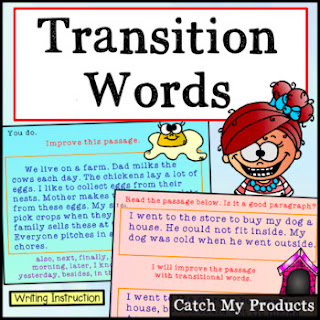When teaching kids how to write, make sure they include transition words for smoother prose. Without these linking words, reading a passage feels like being in a car where the driver constantly slams on the brakes. I like to introduce transition words by giving an example of a passage with and without transition words.
Compare the following passages:
Without Transition Words
My mom drove down Poplar Avenue in Memphis. Another driver cut her off without using a signal. She crashed into the other car's passenger door. She got a ticket. It looked like it was the other guy's fault.
With Transition Words (or words to link the sentences together)
As my mom drove down Poplar Avenue in Memphis, another driver cut her off without using a signal. Unfortunately, she crashed into the other car's passenger door. As a result, she got a ticket. I don't think that was fair because it looked like it was the other guy's fault.
Notice the jarring feel of the first passage when the reader comes to a period? This is why kids need to use transition words.
Let your students practice this technique by giving them examples that do not have transition words and letting them practice connecting the sentences, together. I like to use the gradual release teaching method where I model instruction with the passages above.
Next, allow your students to work with you to correct sentences as a group.
We Do
My dad loves to drink coffee in the morning. He puts the cream and sugar in his cup. He pours coffee on top of it. He stirs the mixture with a spoon. I don't think he needs to stir his coffee.
This passage definitely needs transition words! What words could the kids add to it? I like to use time frame words such as, first, next, then, or finally. I will let the success or failure of the kids determine how many practice sentences are needed.
They Do
This means that the students partner up as a team to fix a choppy passage. It's often a good idea to pair a kid who seems to understand the concept with a struggling student. If you are not sure who gets this, how about using a fist or five? Allow students to hold up fingers to indicate how well they are able to use transition words from a scale of zero to five (five being the best). However, be aware that some kids are shy about admitting that they don't understand, so you may want to have the kids close their eyes. Once kids are partnered up, try this.
Benny is a great dog. He goes outside and gets the paper for my mom. He does not pull when we go for a walk. Benny never barks. He acts like Ella Enchanted because he will come when called. He doesn't look like he always wants to come.
With a partner the kids will make this passage a lot smoother.
You Do
This is the final stage of the gradual release teaching method. Kids will work independently to repair a passage and either turn these in for a grade or give the kids a writing prompt and grade that on how they use transition words.
My aunt likes to order items from Amazon. She goes on the site and looks for what she wants. She places the item in the cart and chooses where it will go and how she will pay for it. She sent me a soccer ball that glides across the floors, indoors, without breaking things. I like when my aunt sends me gifts.
This is a mini-lesson format. If you need help on completing a full lesson on using transition words, I have several PowerPoints to do this. Having a PowerPoint while teaching is like having a friend at the board to tell you what to do. Plus, these work great for distance learning since they may be screen shared. I always used PowerPoints for my directed lessons and evaluations. They were especially helpful when feeling nervous because my lessons told me exactly what to do, step by step. For example, you don't have to worry about forgetting to assess learning. I know a woman who got so nervous during an evaluation that she forgot a kid's name. Wow!
Check these out:
https://www.teacherspayteachers.com/Product/Transition-Words-PowerPoint-1764096 Although this historically based resource does not follow the gradual release process, it has a lot of great features to teach transition words to your 4th, 5th, or 6th grade students. This complete lesson lists standards, has a set, multiple practice passages, vocabulary work, and even a writing prompt. Check out what buyers have said about it!
I have 206 great writing resources at my store,
Catch My Products, on Teachers Pay Teachers. Click the link above to see these writing resources.
New resources are 1/2 off for up to 24 hours after the TpT mailings go out. You can find about these
by following my store, Catch My Products. If you'd like to receive
free resources, be sure to sign up for my mail list
here.





